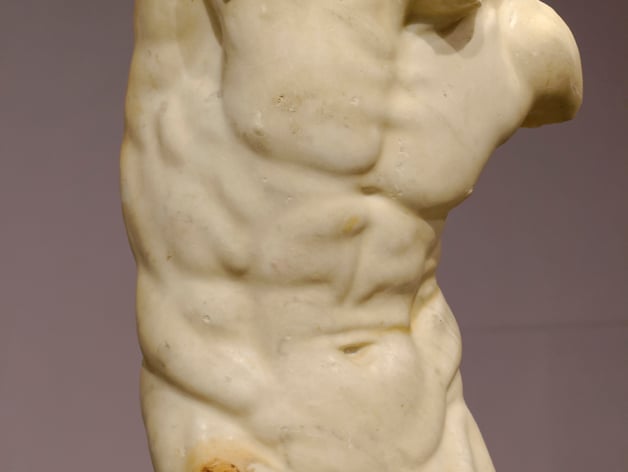
Torso of a Dancing Faun (Invitation to the Dance)
thingiverse
Human: In its pristine form, this figure originally would have possessed a goat tail, still partially visible, pointed ears and tiny horns characteristic of mythological fauns that inhabit ancient forests and pastures. Ancient Romans associated fauns with the deity Faunus who dwells in woodland areas and fields, controlling livestock fertility with supernatural powers. The faun is equivalent to the Greek satyr or god Pan in Roman mythology. This remnant of a marble sculpture depicting a faun may be a Roman copy of an earlier Greek bronze artwork known as "The Invitation to Dance," part of a group where the faun or satyr taps his foot and watches a nymph putting on her shoes. Medium: Sculpture | Marble Size: 26 x 15 3/8 in. (66.04 x 39.05 cm) Creation Place: Europe, Italy/Greece, Roman Civilization Culture: Graeco-Roman, Europe, Italy/Greece Style: 1st century Physical Description: Originally created after a Hellenistic Greek bronze sculpture Credit: Minneapolis Institute of Arts; The Putnam Dana McMillan Fund Accession Number: 70.39 Artist: Artist Unknown (Graeco-Roman) Role: Artist Nationality: Nationality Unknown Provenance: Provenance Unavailable Life Dates: Life Dates Unknown I used the 'Aperture' mode on my Nikon D3100 camera, set to RAW, and utilized a tripod for stabilization, ensuring sharpness. Altogether, I captured around 170 overlapping photos from multiple angles as possible. Thankfully, this sculpture was displayed in a temporary gallery offering ample space to work around it. I then imported the RAW files into Adobe Lightroom to check exposure levels, adjusting them when necessary for even light and shadow distribution. A few minor tweaks were required for areas of deep shadows or blown-out highlights but adjustments remained moderate. After carefully evaluating the captured photos, I eliminated those not suitable for use (mostly due to slight blur on parts of the torso more distant from where the camera was positioned). The remaining images that passed my standards were checked again and exported as 8-bit TIFs instead of 16-bit files due to concerns about burning out the computer under heavy processing workloads caused by dozens of large-sized files. Initially, I attempted directly importing photos into Agisoft Photoscan without creating masks, primarily driven by fatigue and a preference for ease. The resulting model was fairly good but contained sufficient digital noise and background clutter that suggested creating masks before trying again would yield better results. After using Photoscissors to mask the TIF images, exporting these as PNG files enabled accurate segmentation from backgrounds. The next step involved importing the masked files into Agisoft Photoscan for further processing. Upon completion, approximately four or five hours had passed, yielding a reliable 3D model of the Dancing Faun torso ready to share here. For additional refinements, I then imported this 3D model into Meshlab and performed decimation before moving the decimated result over to Meshmixer where holes were sealed. Visual flaws remain but appear inconsequential unless scrutinized closely by an expert familiar with this sculpture. Given that no access to a printer exists at this time, adding a minimal base under the legs or a small plinth would stabilize the 3D model for more optimal viewing experience.
With this file you will be able to print Torso of a Dancing Faun (Invitation to the Dance) with your 3D printer. Click on the button and save the file on your computer to work, edit or customize your design. You can also find more 3D designs for printers on Torso of a Dancing Faun (Invitation to the Dance).
